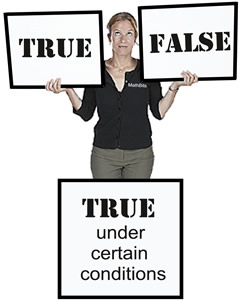|
An algebraic equation is a statement of equality between two quantities or algebraic expressions.
Most algebraic equations are TRUE when certain values are substituted for the variable (such as x), and are FALSE for all other values.
The values that make equations TRUE are called "solutions".
There are, however, "unique" equations that are always TRUE
or always FALSE, no matter what values are subsituted.
|
 |
|
 Equations that are TRUE under certain conditions: Equations that are TRUE under certain conditions: |
These are the majority of algebraic equations.
Consider x - 1 = 9.
This equation has one solution (that makes the equation TRUE) when x = 10, because 10 - 1 = 9 is true. For all other values of x, the equation is FALSE. Such equations can be referred to as conditional equations because they are TRUE only under certain conditions. For all other values, these equations will be FALSE.
|
Remember:
A linear equation (of degree one) has only one value as its solution.
[x + 1 = 6 has one solution, x = 5]
A quadratic equation (of degree two) has two values as its solutions.
[x2 = 16 has two solutions, x = 4 and x = -4]
|
|
 Equations that are ALWAYS TRUE: Equations that are ALWAYS TRUE: |
Consider x + 7 = 7 + x.
This equation has an infinite number of solutions.
Any value you choose for x will make the equation a TRUE statement. This type of equation is called an identity, and the solution set is all real numbers.
A few other examples:
4(x - 1) = 4x - 4
x + x =
2x
(x + 3)(x - 3) = x2 - 9
|
Equations that are identities tend to be statements involving "properties" or "rules", such as a property of the real numbers (commutative property, distributive property, etc.), an arithmetic operation on the variable (addition, subtraction, etc), a rule for factoring, and so on. Both sides of the equation represent the same algebraic expression, just written in a different manner.
|
|
If you solve an equation and you end up with an obvious identity,
such as 5 = 5, you'll know that the orginal equation is also an identity,
with an infinite number of solutions.
|
|
 Equations that are ALWAYS FALSE: Equations that are ALWAYS FALSE: |
Consider x + 7 = x.
This equation has no solutions. No matter what value you choose for x, the equation will be a FALSE statement. Such statements can be referred to as contradictions, or inconsistent.
|
|
If you solve an equation and you end up with an obvious contradiction,
such as 1 = 2, you'll know that the orginal equation is also a contradiction
and has no solutions.
|
|

NOTE: The re-posting of materials (in part or whole) from this site to the Internet
is copyright violation
and is not considered "fair use" for educators. Please read the "Terms of Use". |
|
|